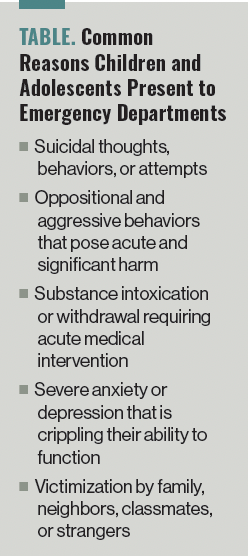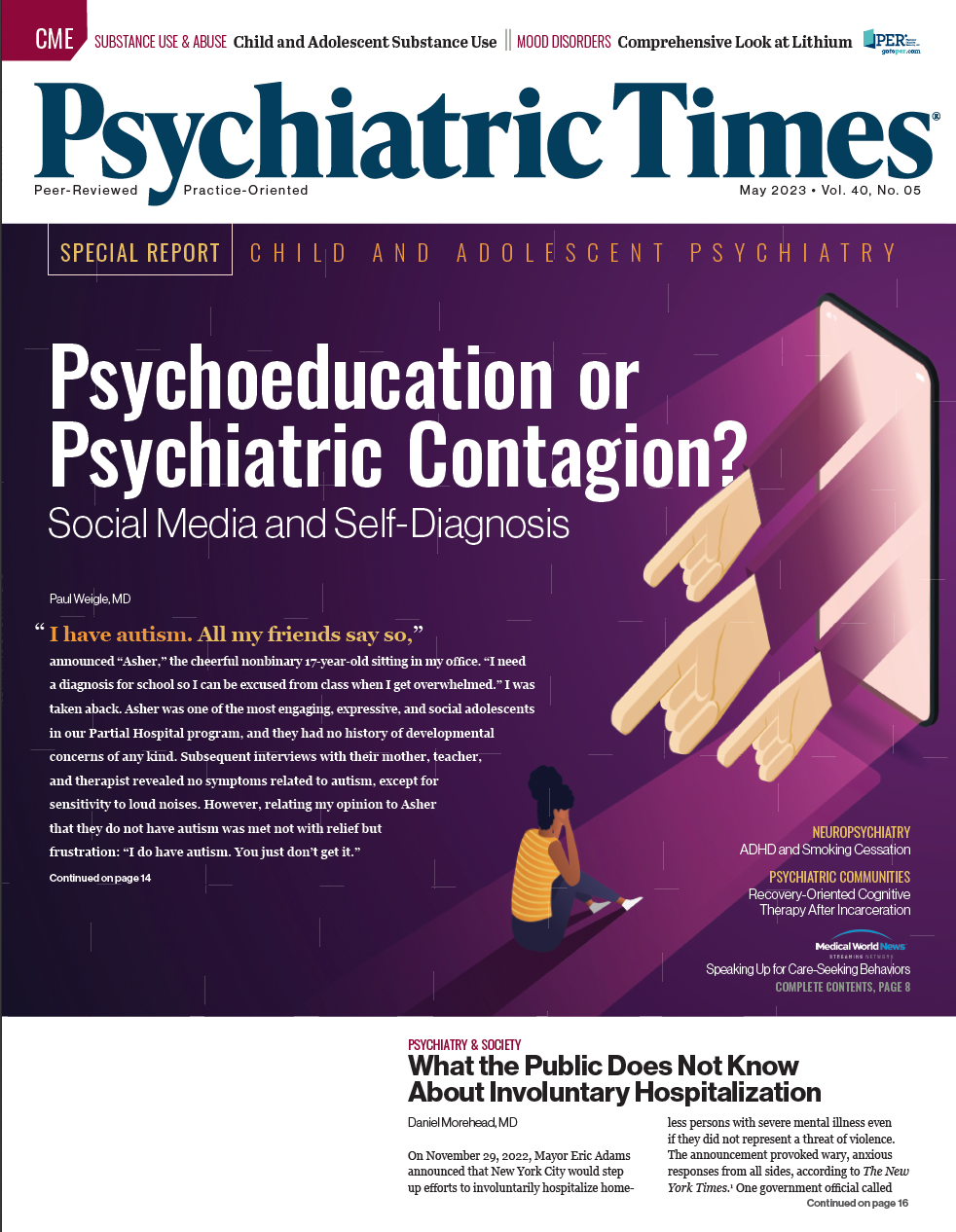Publication
Article
Psychiatric Times
Teach and Treat Your Children Well
Author(s):
"It is essential to have an aggressive path forward to increase public awareness of mental health and illness, education on early intervention and treatment access, and continued destigmatization of mental illness."
New Africa_AdobeStock

This month’s issue of Psychiatric Times® provides a deep dive into a range of topics that coalesce around improving treatment access and psychoeducation to our most valuable societal resource: our children and adolescents. Although as an adult psychiatrist I do not see young patients, it nevertheless is an important area and one in which I strive to maintain proficiency.
Interestingly, the most common serious mental illnesses often do not present until early adulthood, but often the experiences in childhood and adolescence are the tipping point in unmasking and amplifying a genetic vulnerability, which increases the likelihood that an individual will develop a major depressive episode, mania, or psychosis.
Adverse Childhood Experiences
It is well established that any type of early life trauma, either a single significant episode or chronic exposure, increases the risk for future psychiatric symptoms and frank psychiatric disorders. This, of course, includes emotional neglect, nutritional deficits, socioeconomic deprivation, environmental catastrophes, and bullying, as well as physical, emotional, or sexual abuse trauma.
Adding substance use disorder of any type to these factors can cause the developing brain to be wired differently and, in some cases, become permanently impaired.
Emergency Department Crises
The presence of societal dysfunction and chronic stress in childhood has a more immediate and consequential effect as well. During the past 3 years, emergency departments have been overrun by pediatric psychiatric crises, with a paucity of inpatient beds available to appropriately assess, diagnose, and provide competent treatment. Children and adolescents are presenting in acute distress with a variety of issues (Table).
Table. Common Reasons Children and Adolescents Present to Emergency Departments

For example, in the progressive state of Massachusetts, child admissions to emergency departments for mental health crises increased from 200% to 400% during the COVID-19 pandemic. An additional study in 2021 reported that across the United States the number of children waiting in emergency departments for assistance with a mental health disposition increased 300% between 2019 and 2021.1
Increases in Suicide
Suicide is arguably the most dreaded outcome in psychiatry. Looking specifically at individuals under the age of 25, 2020 data from the Centers for Disease Control and Prevention indicated that suicide was the tenth leading cause of death between the ages of 5 and 9, the second leading cause of death between ages 10 and 14, and the third leading cause of death for individuals between the ages of 15 and 24.2
Responding to a call for action by the National Institute of Mental Health’s Task Force on Child Suicide, Ruch et al3 performed a qualitative examination of completed suicides by children aged 5 to 11 years in the United States from 2013 to 2017. The authors reviewed restricted-use data from the National Violent Death Reporting System, a state-based monitoring system that collects data on violent deaths and suicide.
Of the 134 suicides in this age group, the mean age was 10.6 years, 75% were males, 59% were white, and 95.5% of the suicides occurred in the child’s home—most commonly in the child’s bedroom.3 The most frequent method was suicide by hanging or suffocation in 78%, followed by firearms in 19%.3 The authors concluded that potential prevention strategies should include better suicide risk assessment as well as lethal means restriction, especially safe firearm storage.
Addressing Substance Use
Early in my career I led a group for men recovering from severe substance use disorders. Several of the participants reflected on their early childhoods in a town where alcohol use disorders were endemic. They matter-of-factly shared that it was common practice for their parents to bring them to the local bars, where they would give the children a small glass of beer to keep them quiet. One man shared that his parents would put beer in his younger sibling’s bottle to help him sleep.
Not surprisingly, alcohol was a primary contributor to their emotional distress and (often serious) physical health conditions. Despite alcohol being a legal drug that is visibly available and heavily abused in plain sight, a recent article reported that 1 in 8 deaths in adults aged 20 to 64 years in the United States between the years 2015 and 2019 resulted from excessive alcohol use.4
Alcohol is not the only legal substance causing problems for our youth. In 2012, Colorado and Washington became the first states to legalize the recreational use of cannabis. As of February 2023, an additional 19 states have followed suit and another 10 states have decriminalized it. Cannabis dispensaries now abound, with associated states tax revenues from the sale of cannabis skyrocketing.
My observation is that the legal status of cannabis has resulted in a misperception by many individuals that cannabis, or more specifically THC, is safe. As with alcohol, THC has been shown to have significant risks, especially for individuals younger than 25 who are heavy cannabis users, because their brains are still developing. Established risks in this population are an increased risk of psychosis and a decline in cognitive function.5,6
Of greater concern is the prolific use of many drugs, especially when bought on the street from unknown sources and with unknown content, including but not limited to heroin, fentanyl and other opioids, xylazine, 3,4-methylenedioxymethamphetamine (MDMA, ecstasy), bath salts, cocaine, crystal meth, ketamine, and synthetic cannabinoids. Articles in this month’s and next month’s issues of Psychiatric Times will explore this topic in further detail.
Concluding Thoughts
As with any disease or disorder, the most effective yet most underutilized intervention is prevention followed closely by early intervention. Both of these are appreciated from an intellectual perspective by mental health providers and policy makers.
However, we find ourselves overwhelmed by a ubiquitous mental health crisis, especially for children and adolescents in the United States and throughout the world. An approach that is rapidly gaining momentum is improving timely assessment and intervention by embedding psychiatric providers in pediatric clinics, thereby creating integrated collaborative care models.
Increased funding is essential and should be a high priority in national, state, and local governments. Incentives to increase enrollments in mental health professions, followed by equitable salaries in parity with other medical specialties, could increase the availability of much-needed and well-trained clinicians.
Finally, it is essential to have an aggressive path forward to increase public awareness of mental health and illness, education on early intervention and treatment access, and continued destigmatization of mental illness.
Dr Miller is Medical Director, Brain Health, Exeter, New Hampshire; Editor in Chief, Psychiatric Times; Staff Psychiatrist, Seacoast Mental Health Center, Exeter; Consulting Psychiatrist, Exeter Hospital, Exeter; Consulting Psychiatrist, Insight Meditation Society, Barre, Massachusetts.
References
1. Stock S, Zalani A, Hacker C, et al. Children languish in emergency rooms awaiting mental health care. CBS News. February 28, 2023. Accessed April 17, 2023. https://www.cbsnews.com/news/emergency-rooms-children-mental-health/
2. National Institute of Mental Health. Suicide. Accessed April 17, 2023. https://www.nimh.nih.gov/health/statistics/suicide
3. Ruch DA, Heck KM, Sheftall AH, et al. Characteristics and precipitating circumstances of suicide among children aged 5 to 11 years in the United States, 2013-2017. JAMA Netw Open. 2021;4(7):e2115683.
4. Esser MB, Leung G, Sherk A, et al. Estimated deaths attributable to excessive alcohol use among US adults aged 20 to 64 years, 2015 to 2019. JAMA Netw Open. 2022;5(11):e2239485.
5. Andrade C. Cannabis and neuropsychiatry, 2: the longitudinal risk of psychosis as an adverse outcome. J Clin Psychiatry. 2016;77(6):e739-e742.
6. Meier MH, Caspi A, Ambler A, et al. Persistent cannabis users show neuropsychological decline from childhood to midlife. Proc Natl Acad Sci U S A. 2012;109:E2657-E2664.







